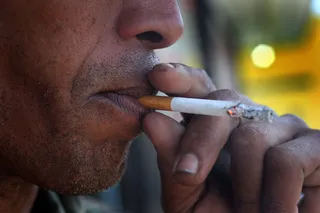The 411 on Electronic Cigarettes
E-cigs are growing in popularity. But are they healthy?

1 / 14
Smoking Up - The New York City city council voted this week to ban the use of e-cigarettes in indoor public places, reports NPR. Read more about the rise of e-cigs and the impact smoking has on the African-American community. – LaToya Bowlah (Photo: Oli Scarff/Getty Images)

2 / 14
What Are E-Cigs? - First patented and introduced to the Chinese market in 2004 by a company called Ruyan, e-cigarettes first began to reach America’s markets in 2006. Though touted as a healthy alternative, the health effects of e-cigs are still largely unknown. (Photo: Mike Kane/Bloomberg via Getty Images)

3 / 14
How They Are Made - E-cigarettes look and feel almost exactly like regular cigarettes. There’s an LED light at the release-point. E-cigs contain a mechanism that heats up a liquid mixture of nicotine, water, propylene glycol and glycerol, which turns into a vapor that is inhaled and exhaled by the user. (Photo: REUTERS/Christian Hartmann)

4 / 14
The Health Hype - Manufacturers portray e-cigarettes as a healthier alternative to traditional tobacco smoking but with the same satisfaction. Smoking Everywhere e-cigs have been described as "providing smokers the same delight, physical and emotional feelings they get in smoking traditional cigarettes." (Photo: Spencer Platt/Getty Images)

5 / 14
Are They Really Healthier? - Smoking e-cigs do not guarantee lower nicotine consumption. Users can choose cartridges containing nicotine in a range of strengths. The effects of inhaling pure nicotine has yet to be adequately studied, and the Food and Drug Administration is concerned that e-cigs may still be a health hazard. (Photo: dpa/Landov)
ADVERTISEMENT

6 / 14
What About Secondhand Vapor? - Individuals with health conditions have reported that the e-cigs vapor irritates their eyes, nose, throat and makes them nauseated. Critics of e-cigs argue that until manufacturers have proven that the vapor is safe for children, the elderly and people with certain medical conditions, people should not be subjected to secondhand vapor. (Photo: Spencer Platt/Getty Images)

7 / 14
The Rise of Electronic Cigarettes - New brands such as bluCigs, Green Smoke and NJOY have emerged recently. Unlike traditional cigarettes, e-cigs advertise on the radio and television and flaunt nicotine cartridges in a spectrum of flavors from chocolate to bubble gum. E-cigs are likely to appeal to kids and can easily be purchased online. Of high-school students who smoke in the U.S., 10.5 percent are African-American. (Photo: Spencer Platt/Getty Images)

8 / 14
Kids and E-Cigs - According to a new study by the Centers for Disease Control and Prevention, children are increasingly trying electronic cigarettes. The age of high school students who reported ever using an e-cigarette rose from 4.7 percent in 2011 to 10.0 percent in 2012. In the same time period, high school students using e-cigarettes within the past 30 days rose from 1.5 percent to 2.8 percent. Altogether, in 2012 more than 1.78 million middle and high school students nationwide had tried e-cigarettes, says the CDC. (Photo: Spencer Platt/Getty Images)

9 / 14
African-Americans and Smoking Rates - While 19.4 percent of African-Americans are currently cigarette smokers, research shows that more than 70 percent want to quit. But not only do we have less success in quitting, we also pay the greater price for smoking. Blacks are more likely to develop and die from cancer than their white counterparts. (Photo: Daniel Barry/Getty Images)

10 / 14
A Generation of Users - The GfK MRI Survey of the American Consumer shows that 40 percent of adults who smoked cigarettes in the last 12 months were millennials (anyone born from 1977 to 1994). According to Forbes’ first consumer data on e-cigarettes, 44 percent of smokers who used one of these devices were also millennials. (Photo: Marie-Reine Mattera/Getty Images)
ADVERTISEMENT

11 / 14
The Cancer Stick - Each year, approximately 45,000 African-Americans die from smoking-related diseases. Smoking is the cause of 80 percent of all lung cancer deaths, and lung cancer is the second most common cancer among African-American adults. (Photo: Jan Pitman/Getty Images)

12 / 14
Menthol and You - Prior to e-cigarettes, menthols were another variant of nicotine consumption. As studies developed, menthols were proven to be equally as dangerous as regular cigarettes. By 2012, more than 75 percent of African-American smokers used menthols; and of African-American youths who smoke, more than 80.4 percent prefer menthols. (Photo: Joe Raedle/Getty Images)

13 / 14
Smoking and Racial Health Disparities - Death from smoking-related disease is higher among African-Americans than among their white counterparts despite the fact that African-Americans typically smoke less. (Photo: Joe Raedle/Getty Images)
Photo By Joe Raedle/Getty Images
